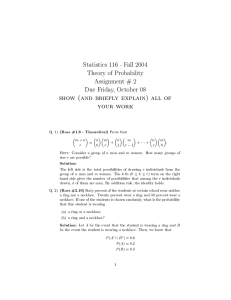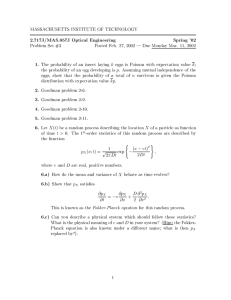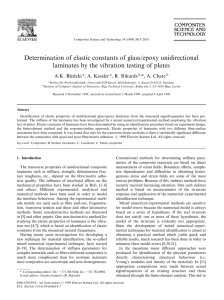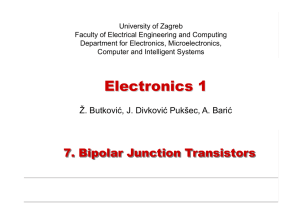Solutions
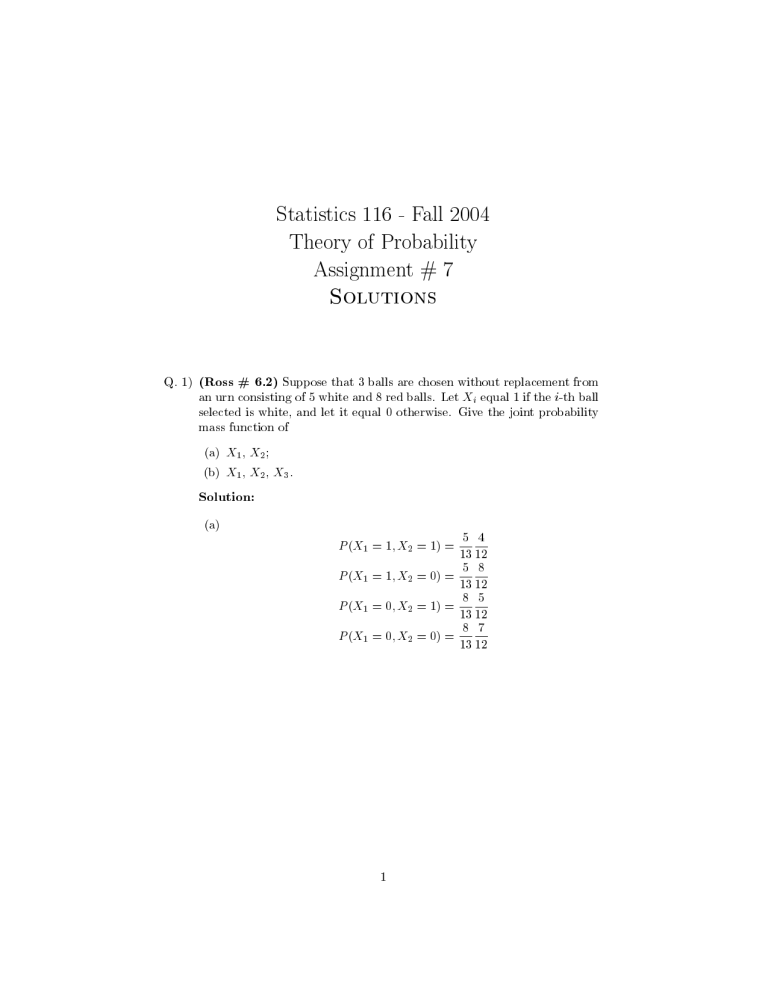
Statistics 116 - Fall 2004
Theory of Probability
Assignment # 7
Solutions
Q. 1) (Ross # 6.2) Suppose that 3 balls are chosen without replacement from an urn consisting of 5 white and 8 red balls. Let X mass function of i equal 1 if the i-th ball selected is white, and let it equal 0 otherwise. Give the joint probability
(a) X
1
, X
2
;
(b) X
1
, X
2
, X
3
.
Solution:
(a)
P (X
1
= 1; X
2
= 1) =
P (X
P (X
P (X
1
1
1
= 1; X
= 0; X
= 0; X
2
2
2
= 0) =
= 1) =
= 0) =
4
12
8
12
5
12
7
12
5
13
5
13
8
13
8
13
1
(b)
P (X
1
= 1; X
2
= 1; X
3
= 1) =
P (X
P (X
P (X
P (X
P (X
P (X
P (X
1
1
1
1
1
1
1
= 1; X
= 0; X
= 0; X
= 1; X
= 1; X
= 0; X
= 0; X
2
2
2
2
2
2
2
= 0; X
= 1; X
= 0; X
= 1; X
= 0; X
= 1; X
= 0; X
3
3
3
3
3
3
3
= 1) =
= 1) =
= 1) =
= 0) =
= 0) =
= 0) =
= 0) =
12
5
12
7
12
12
4
12
8
12
5
12
7
4
12
8
13
8
13
8
13
13
5
13
5
13
8
13
8
5
13
5
11
7
11
6
11
11
8
11
7
11
4
11
5
3
11
4
Q. 2) (Ross # 6.6) A bin of 5 transistors is known to contain 2 that are defective. The transistors are to be tested, one at a time, until the defective ones are identied. Denote by N
1 defective is identied and by N
2 the number of tests made until the rst the number of additional tests until the second defective is identied: nd the joint probability mass function of
N
1 and N
2
.
Solution:
Imagine drawing all 5 transistors and testing each one in order. Each outcome is equally likely and the number of outcomes is equal to the number of ways of choosing two \defective" transistors out of a set of 5, of which there are 5
2
= 10 ways. Hence the probability
P (N
1
= i; N
2
= j) =
1
10
1 i < j < 5:
Q. 3) (Ross # 6.9) The joint probability density function of X and Y is given by f(x; y) =
6
7 x 2 + xy
2
; 0 < x < 1; 0 < y < 2:
(a) Verify that this is indeed a joint density function.
(b) Compute the density function of X.
(c) Find P (X > Y ).
(d) Find P (Y > 1=2jX < 1=2).
(e) Find E(X).
(f) Find E(Y ).
Solution:
2
(a)
Z
1
Z
1
1
1 f(x; y) dx dy =
=
=
=
=
=
Z
1
Z
0
1
6
7
6
7
Z
+ x 2 x 2 xy
4
2
+
6
7
6
0
Z
7
Z
0
1
0
1
(x 2
2x 2
0 y +
+ x dx
2x
2
3
3
2
3
6
7
2
+
1
2
6
7 x
2
2
+ xy
1
0
2 xy
2 dy dx
2
0
) dx dy dx
= 1:
(b) From our above calculations f
X
(x) =
=
=
Z
Z
0
1
2
1
6
6(2x
7 f(x; y) dy
2 x 2
+ x)
+ xy
2
7
(c) dy
P (X > Y ) =
=
=
=
=
=
=
=
ZZ
6
7
Z
6
7
6
7
6
7
6
7
15
16
56 f(x; y) dy dx
(x;y):x>y
1
Z x f(x; y) dy dx
Z
1
1
Z
Z
5
4
5
0
0
0
Z
1
1
0
Z
1
0
1 x x 2 x 3 x 3 x 2 y +
+ dx
+ x
4 xy
3 xy
4
2
2 dy dx x
0 dx dx
3
(d)
P (Y > 1=2jX < 1=2) =
P (Y > 1=2; X < 1=2) =
=
=
=
6
7
6
7
6
7
6
7
Z
Z
Z
P (Y > 1=2; X < 1=2)
0
0
0
1=2
1=2
1=2 x
2
3
P (X < 1=2)
Z
2
1=2 x 2 + xy
2 x 2 y + xy
4
2
3x
+
2
2
+
15x
32
2
15
16
0 x dx
1=2
!
2 dy dx
1=2
!
dx
=
=
P (X < 1=2) =
=
=
=
6
7
6
7
6
7
6
7
6
7
6
7
1
16
23
128
Z
1=2
+
0
2x
3
3
15
128
2x 2
+ x
+ x dx
2
1=2
!
2
0
5
24
1
12
+
1
8
P (Y > 1=2jX < 1=2) =
23
128
5
24
' 0:86:
(e)
E(X) =
6
7
Z
0
1
2x 3 +x 2 dx =
6
7 x 4
2
+ x 3
3
1
!
=
0
6
7
1
2
+
1
3
=
6
7
5
6
=
5
7
:
4
(f)
E(Y ) =
=
=
=
=
=
6
7
6
7
6
7
6
7
6
7
8
7
:
Z
Z
0
1
1
Z
2
0 x 2 x 2 y + y 2
+
Z
0
1
2x 2
0
2x 3
3
+
2
+
4x
3
3
2x 2
0 xy 2
6
2 xy 3 dx
1
!
2
3
+
2
3 dy dx
2
!
dx
0
Q. 4) (Ross # 6.20) The joint density of X and Y is given by f(x; y) =
( xe
0
(x+y) x > 0; y > 0 otherwise.
Are X and Y independent? What if f(x; y) were given by f(x; y) =
(
2 0 < x < y; 0 < y < 1
0 otherwise.
Solution:
In the rst case: yes, because f(x; y) = xe x 1
[0;+1)
(x) ye y 1
[0;+1)
(y):
In the second case: no, because the support of the random vector is f(x; y) : 0 < x < y; 0 < y < 1g which is a triangle, and is not the Cartesion product of two sets. Hence
X and Y cannot be independent.
Q. 5) (Ross # 6.29) When a current I (measured in amperes) ows through a resistance R (measured in ohms), the power generated is given by I variables with densities
2 R
(measured in watts). Suppose that I and R are independent random f
I
(x) = 6x(1 x) 0 x 1; f
R
(x) = 2x 0 x 1:
5
Determine the density function of W .
Solution:
First, we nd the distribution function of W . For any distribution of I and R such that they are independent and non-negative
F
W
(w) = P (W w)
= P (I 2 R w)
= P (f(i; r) : i 2
=
Z
1
Z w=i 2 f
=
Z 0
1 f
0
(i)F r wg)
R
(r)f
I
(i) dr di
) di:
0
I R
(w=i 2
Therefore, the density f
W
(w) =
= d dw
1
Z
0 f
I
0
1
(i) f
I
1 i 2
(i)F
R f
R
(w=i
(w=i 2
2 ) di:
) di:
In our particular example this boils down to, for 0 < w < 1 f
W
(w) =
Z
1 p w
6i(1 i)
Z
1
= 12w
= 12w p w
1 i
1 i 3
1
2i 2
1 i 2
1 i 2
1
2w i 2 p w di
!
di:
= 6w 12w 1=2 + 6:
The range of integration in the rst line comes from the fact the density f
R
(w=i 2 ) is non-zero only if w=i 2 1.
6
